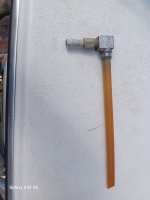nope, motor is designed like a p-trap. water will drain to the top of the thermostat housing at best unless you pull the block drains
Ahh yes I see that now. Earlier I made the mistake of thinking the lower pipe from the water pump (which connects to the thermostat housing) was connected lower to the raw water pump.
I decided to use the new BPR4FS plugs I already have so I put them back in. It was much easier using the socket I adapted even though I'm still using the 1/4 impact universal joint instead of finding/buying a normal (shorter narrower) 1/4 normal universal joint.
Refitted the old plug leads, they go on much easier than the new.
Test fitted the new V belts, they all fit OK. Removed the raw water pump belt again.
Disconnected the positives from the coil. Connected a battery to the port side battery connectors and tried to crank the engine, the starter tried to crank the engine but clicked on/off as though the battery were flat. Tested the battery, it had good charge at 12.8V which made me worried I hadn't fitted the starter motor properly. Tried cranking again, smoke came from the port side negative battery cable near where it connects to the battery. I looked at the battery cable, someone has put tape around the area the cable was smoking from so I thought maybe someone tried to join wires under the tape... but still worried in case there was a problem with the starter motor (I know the engine turns OK by hand cranking). I didn't check under the tape but moved the battery to the starboard side battery connectors, switched the battery selector to the starboard side battery and tried cranking again, this time it cranked no problem

..so it seems I need to look under the tape on the port side battery earth wire. I only cranked it for a few revolutions but still have a concern.. At a certain position during cranking (say just where one of the cylinders would be on compression stroke) the cranking speed increased, could tell by the sound, so I'm hoping there isn't going to be a problem with compression on one cylinder, maybe it's just because a lifter needs to bleed etc. Any thoughts on this? If you disable the ignition on your boat / car and crank the engine does the cranking speed the same or is there a certain point (like for maybe compression on one cylinder) where cranking speed seems to increase?
The gauges (volts, temp, oil pressure, trim) do move with the ignition on. With ignition off they all point too far to the right, with ignition on they all point even further to the right and go off scale... It's as though the base reading for all the gauges has moved from pointing to the left to pointing somewhere in the middle, so maybe I can fix the gauges just by pulling the needles off and putting them back on in the correct position? If that is true I wonder if at some point someone has connected a battery the wrong way making the gauges point further to the left and moving the base position by moving the axes inside the needle pointers. A friend was here while I was testing the cranking and gauges, I had him move the part on the transom that goes up/down/steers, the trim gauge does move with the transom part but it starts in the middle and goes off scale to the right pointing way past the down position when the transom bit is pushed all the way down.
Seems I lost a couple of jubilee clips for the pipes that run from the thermostat housing to the exhaust manifolds but I think I have a pack of mixed jubilee clips, so next thing on my to-do list is find the pack of jubilee clips. I might even get around to priming the cooling system, reconnect the igniton wires at the coil and dizzy cap, fill the pas pump, make some adapter to connect the hosepipe to the thermostat housing and try to start the engine...





















